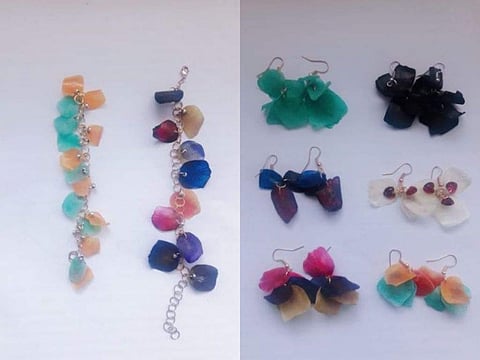

If you’re a non-vegetarian, we can bet that the first thing that you think of when you hear the word ‘fish’ is food. Let us stop you right there, before images of delicious fish curry or fried fish flash in your mind and make you (and us!) hungry. Today, we're going to talk about fish in a completely different context. This is a story about two youngsters from Coimbatore, Nivetha Balakrishnan and Mahaalakshmi A, who used fish scales, a part of the fish that is often discarded when it’s cleaned, and made beautiful jewellery out of them! However, they did not just look at the aesthetics of creating something unique, but also the environmental aspect. “As part of our BSc Zoology course at PSGR Krishnammal College for Women, we were out in the Ukkadam fish market, studying the taxonomy of different types of fishes when we noticed fish scales being thrown away along with the other fish ‘waste’. This got us thinking – why not do something unique using fish scales? The 3Rs of environment conservation are reduce, reuse and recycle. Keeping the ‘reuse’ principle in mind, Nivetha, who was my classmate then, and I started experimenting with scales for our group project,” says Mahaalakshmi, who is currently pursuing MSc Zoology in Vivekanandha College for Women, Tiruchengode.
But why did they choose fish scales specifically? “We wanted to do something related to fish as it was the theme of the project. We were particular that we wanted to make some feature of the fish stand out," Mahaalakshmi says, while Nivetha explains the whole process, “We used the scales of the Catla and Rohu fish as we believed they would look very attractive, owing to their large size. Since it is a student project, we used laboratory dyes to add colour to the scales. We did not know whether the dyes would work or the colour would stay for long as we had zero knowledge of the properties of fish scales, but fortunately for us, they did. The lab did not have a wide variety of colours, but we used whatever we had access to, like methyl orange, safranin, potassium iodide and others. The key was mixing colours until we achieved the desired effect. And our little experiment worked!”
However, their 'little experiment' came with its own set of challenges. “The most difficult thing was dealing with the fishy smell. In fact, we had given up many times, especially when we had to wash the scales out, but thankfully, we bounced back soon," recalls Mahaalakshmi. “Once we remove the skin attached to the scales and wash it properly with soap and water, the stinky smell gradually fades away," Nivetha points out. While the idea of creating something using fish scales was Mahaalakshmi’s, Nivetha was the one who gave shape to it and crafted different jewellery pieces like earrings, necklaces, bracelets and even paperweights using her ‘four-step’ method. “Looking at the final product, many of our friends mistook the scales for dried rose petals. They could not believe it when we said that they were treated fish scales,” laughs Nivetha.
